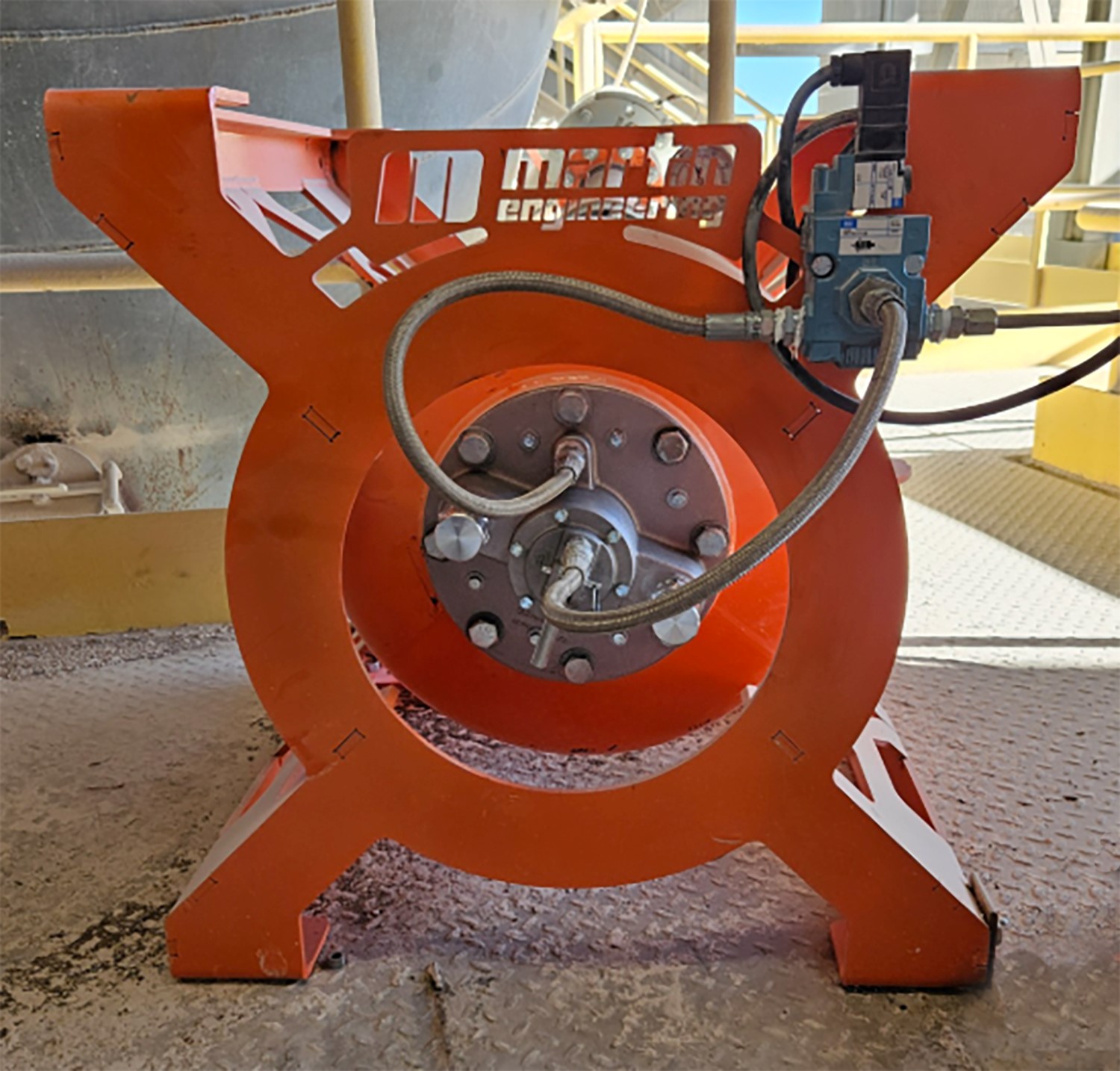Martin Engineering has introduced a heavy-duty air cannon mounting system, the Martin® X-Stand, that, it says, safely keeps air cannons away from super-heated or potentially hazardous areas while offering easy service access.
The result is clearer walkways, improved safety and greater maintenance efficiency for a lower cost of operation, it claims.
“Though secure when held in place by pipework, air cannons can be precariously placed around preheaters, hoppers and drop chutes, making them hard to get around or reach by maintenance crews,” Sid Dev, Product Manager of Air Cannons at Martin Engineering, said. “Some of these applications can also be in high-heat environments in loading zones, so we worked with customers to formulate a more practical and long-term solution. The X-Stand ended up having more benefits than we initially thought!”
The X-Stand is a rugged steel cube frame that comes in three sizes to fit the 35-litre, 70-litre and 150-litre air cannon tanks. These fit Martin® Hurricane and Typhoon Air Cannons. The largest model measures 36 x 36 x 36 inches (91.5 x 91.5 x 91.5 cm) and weighs circa-175 lb (circa-80 kg).
Each cube has a sturdy cross-bar frame designed to distribute weight and absorb vibration from the cannon’s firing. The central top hole allows easy access to the valve and attachments, while the bottom hole accommodates a standard circa-10 cm, 150-lb, 8-bolt ANSI (American National Standards Institute) flange to hold the cannon securely in place. The open sides allow easy access to the flange, hose connection and tank removal. Solenoid boxes that enable manual firing and control the firing sequence can be conveniently mounted on the side of the rack.
The X-Stand is specially designed to fit different spaces and stack in several configurations for optimum space-saving, safer access and ease of maintenance. The air cannons are still secured with a tether for added safety. X-Stands are delivered in assembled blocks with all the bolts and nuts required to secure them using standard tools. Air cannons are sold separately.
Air cannons are the most effective way to clear material that’s adhered to preheater vessels or silo walls, as well as clogs in hoppers, bins and drop chutes, Martin Engineering says. Instead of exposing workers to extreme heat, having them beat vessel walls with hammers, or entering dangerous confined spaces, air cannons do the job safely and remotely.
They comprise a 35, 70, or 150-liter tank connected to a compressed air system that delivers a powerful shot triggered from a solenoid box up to 200 ft away. Pointed in the direction the material flows, the high-velocity air passes through a nozzle across vessel surfaces to dislodge adhered material and clogs, promoting efficient throughput with minimal downtime.
Martin Engineering just celebrated the 50th anniversary of inventing Air Cannon technology. It holds the intellectual property for low-pressure cannons and continues to work on incrementally improving the technology for greater efficiency.
Air cannons are commonly secured to a nozzle assembly next to the vessel. A wire tether ensures the tank doesn’t fall should it suddenly detach from the assembly. This positioning can make access a challenge, particularly when the units are set close to a hot wall like a preheater or kiln.
The positioning also becomes an issue when air cannons jut into narrow walkways, or workers must step over 4-inch tubing to access maintenance areas. Since trips and falls commonly top the list of workplace injuries, proper headspace and unobstructed walkways help staff move through the area easily – particularly important when carrying large or unwieldy equipment or replacement parts.
Installing an X-Stand system allows air cannons to be placed in the optimum position and provides the opportunity to rearrange tubing leading to nozzles. Moreover, equipment can be moved away from areas of extreme heat. This reconfiguration ensures safe passageways and maintenance access, improving workplace safety.
“Through testing, we’ve found that there is negligible air blast power loss by extending the distance a few feet, and only about 5% power is lost with each elbow in the pipe,” Dev said. “With strategic placement, the X-Stand will deliver safety results that justify any increase in the number of shots per sequence.”
Some air cannon installations require mesh tubing to properly accommodate the tank’s position and handle vibration from firing. Although commonly made with metal strands, the mesh tubing is considered a wear part that needs changing after long-term exposure to the punishing production environment, heated walls, and constant vibration. The X-Stand promotes the use of hard pipes with a longer equipment life and less maintenance for added safety and a lower cost of operation.
After testing, participating operators said they liked the more organized approach in helping to keep congested operational areas as clear as possible. They were impressed with the cleaner look and the innovative solutions to pipe placement. Participants in field tests recognized no substantial change in performance from the original configuration.
“Martin is always listening to customers for ideas to improve safety and efficiency,” Dev concluded. “The X-Stand is a result of that and is the next step to a clean, safe, and efficient bulk handling operation.”











